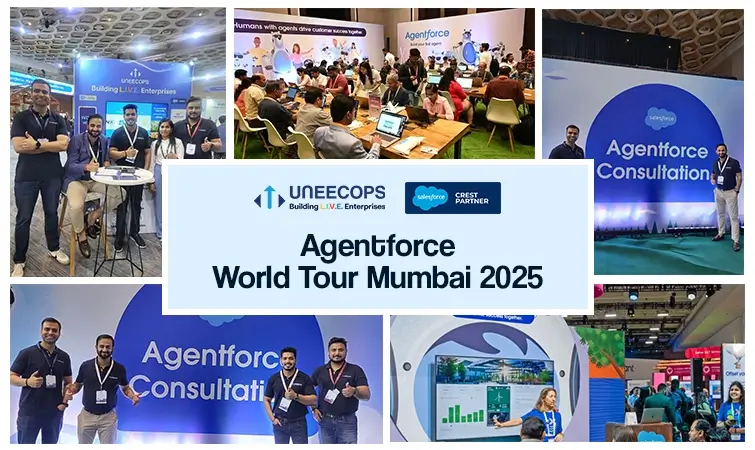In the modern digital landscape, achieving seamless integration is essential for businesses harnessing Salesforce CRM integration to streamline operations and elevate customer experiences.
With its high degree of customization, Salesforce enables organizations to seamlessly integrate with compatible third-party applications and services, consolidating data and functionalities into a unified platform.
However, despite the Salesforce solution’s robust capabilities, integrating it with other systems presents notable hurdles. From managing disparate data sources to navigating intricate business processes, businesses encounter various obstacles on the path to successful integration.
In this article, we’ll delve into the common challenges in Salesforce integration services, explore effective strategies to surmount them, and see how Uneecops helps organizations in laying the roadmap for Salesforce implementation.
1. How To Reduce Data Complexity and Achieve Data Quality
A significant obstacle in Salesforce integration services revolves around managing diverse data formats, structures, and quality across multiple systems. Data may suffer from duplication, incompleteness, or inconsistency between systems, impeding decision-making processes, and creating inaccuracies.
To tackle this issue, businesses should prioritize investment in data cleansing, normalization, and, standardization procedures before integration. Leveraging data integration tools with transformation functionalities can streamline data preparation, guaranteeing data integrity across systems.
2. How To Plan Integration Architecture and Mitigate Data Mapping Complexities
Integrating a Salesforce solution typically entails linking diverse applications, databases, and platforms characterized by varying architectures, protocols, and APIs. A primary hurdle lies in the data mapping complexities and data transformation among these distinct applications.
Overcoming this complexity necessitates meticulous planning and the establishment of a well-defined integration architecture. Embracing a modular and scalable approach, such as harnessing middleware platforms or API management solutions, can streamline integration workflows and facilitate seamless communication among Salesforce and other applications. It’s crucial to develop an extensive comprehension of the structures of data and its formats to ensure precise data mapping.
3. How To Handle Data Sensitivity, Security, and Compliance
Data security and compliance hold significant importance in Salesforce integration services, particularly when handling sensitive customer information or operating within regulated industries. Safeguarding sensitive data throughout the integration process is paramount.
This requires implementing robust authentication mechanisms, encryption protocols, and access controls to safeguard data privacy and comply with industry regulations and standards. Conducting regular security audits and monitoring activities aids in identifying vulnerabilities and maintaining compliance with evolving security standards. It’s imperative to ensure data encryption both during transit and at rest. Furthermore, the integration of robust access controls, such as role-based access control (RBAC), aids in limiting unauthorized entry. Regularly reviewing and updating security configurations is essential to mitigate emerging threats effectively with Salesforce CRM integration.
4. How To Maintain Real-time Data Synchronization
Maintaining real-time data synchronization between a Salesforce solution and external systems poses a common challenge, especially in high-volume environments. This gap arises when data across various organizational systems or databases isn’t promptly aligned or updated, resulting in duplicate records, inconsistencies, and outdated information.
To tackle this, organizations need a robust data synchronization strategy, encompassing defined governance policies, data quality standards, and integration tools with real-time capabilities. By ensuring synchronized data, organizations access accurate, current information within Salesforce, enhancing insights and customer interactions. Leveraging event-driven architectures and asynchronous messaging, along with tools like change data capture (CDC) or Salesforce Connect, enables near real-time updates, and minimizes data replication latency.
5. How To Strike A Balance Between CRM and Legacy System Integration
Executing Salesforce CRM integration with legacy systems, often characterized by outdated technologies or proprietary interfaces, presents distinct challenges. This integration effort may entail linking Salesforce solutions with third-party systems or legacy applications, each with its technical specifications.
Adapting legacy systems for seamless integration demands a thorough evaluation of compatibility, data mapping, and API accessibility. Employing integration adapters, middleware platforms, or custom-built connectors can bridge the divide between Salesforce and legacy systems, facilitating bidirectional data flow and interoperability. Early assessment of system compatibility and API limitations is crucial. Collaborating with seasoned developers and leveraging middleware or integration tools are essential steps to bridge the gap between systems effectively.
6. How To Monitor Cost Management and Track ROI
Salesforce integration services with other systems involve initial investments in infrastructure, development, and ongoing maintenance. Before commencing a Salesforce integration project, meticulous planning, and cost management aligned with budgetary constraints are essential. Businesses frequently encounter challenges in adhering to their budget while synchronizing data with third-party solutions.
To validate these expenditures and monitor return on investment (ROI), businesses should define precise success metrics and performance benchmarks. Consistent performance evaluations, cost-benefit analyses, and ROI assessments empower stakeholders to gauge the efficacy of Salesforce CRM integration endeavours and make well-informed choices regarding resource allocation and optimization.
With all this discussion we are sure that a successful Salesforce Integration with other systems requires expert know-how of diverse tools, techniques, best practices, and an appropriate roadmap above all. Let us read the bouquet of Salesforce Integration services that Uneecops brings in.
Overcome Challenges with Uneecops’ Salesforce Integration Services
Overcoming the hurdles of Salesforce integration services necessitates a blend of technical prowess, strategic foresight, and a commitment to ongoing enhancement. By proactively tackling challenges such as data complexity, architectural design, and security considerations, businesses can fully harness the strength of Salesforce CRM integration to drive innovation, boost agility, and deliver outstanding customer experiences.
Sometimes even with the right approach and tools in place, navigating through the intricacies of Salesforce integration services becomes challenging. However, partnering with an experienced Salesforce integration service provider not only unlocks opportunities for sustainable growth but also cultivates a competitive edge in today’s dynamic marketplace.
Uneecops is a leading Salesforce Integration Partner that bridges the gap between business systems by integrating them seamlessly, enabling you to have centralized access to all the customer information, and allowing you to make data-driven decisions with ease. We consult with the key stakeholders to determine the best solution for integrating your systems, ensuring that the integrated system essential for the business is set up.
Our Salesforce Professionals embrace standardized protocols and foster collaboration between IT and business teams are vital strategies for ensuring successful Salesforce CRM integration with minimal disruptions, ultimately paving the way for organizational success and customer contentment.
Some of our Salesforce Integration services include
- Data Integration – Make the most of your data warehouses, by combining Salesforce data with other sources and vice-a-versa
- UI Integration – Integrate diverse applications within Salesforce for a pleasant UI experience
- API Integration – Connect CRM with other systems, such as e-commerce platforms, accounting software, payment platforms, or legacy systems
- Third-Party Integration – Integrate current applications and external cloud services with Salesforce in just a few clicks
- Backend Integration – Connect backend elements for smooth performance and take your enterprise backend systems to another level of efficiency
- Digital Commerce Integration – Integrate the Salesforce CRM system with your eCommerce business to amplify customer relations
Please feel free to connect with us to learn more about our Salesforce Integration Services. Not sure where to start? Get a customized Salesforce integration roadmap from our specialists. Get Started.







